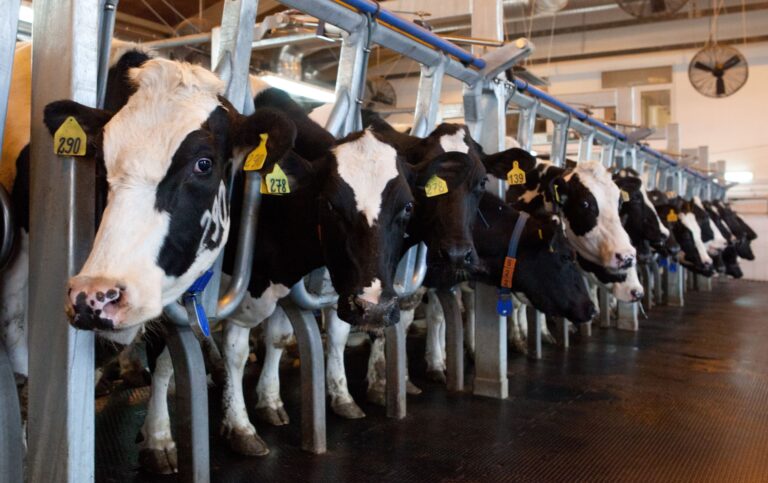Beef farms are a critical part of the global agricultural landscape, providing much of the meat consumed worldwide. These farms vary greatly in size, operation, and management practices but all share the common goal of raising cattle for high-quality beef production. Understanding how these farms operate gives insight into the food system and the journey of beef from farm to table.
1. Types of Beef Farms
Beef farming involves different methods and stages of raising cattle, each suited to the specific needs of the animals and the farm’s objectives. The main types of beef farms include:
Cow-Calf Operations
These farms focus on breeding cows (adult females) and producing calves. After birth, calves are raised alongside their mothers and typically graze on pasture. The calves are weaned at around 6 to 10 months and sold to other farms for further growth. Cow-calf farms are foundational to the beef industry because they produce new generations of cattle for the supply chain.
Backgrounding Operations
Once calves are weaned, they may be sent to backgrounding farms. These farms focus on grazing the cattle and ensuring they grow to an appropriate weight before moving on to the next stage. Backgrounding helps to prepare the animals for feedlots or other finishing operations by transitioning them from a milk-based diet to grazing.
Feedlots
These are large-scale operations where cattle are brought to be “finished,” or fattened, before slaughter. Feedlots provide a controlled environment with a high-energy diet, typically made up of grains like corn and soybeans, to encourage rapid weight gain. Feedlot cattle are usually around 12 to 18 months old when they enter this stage, and they spend anywhere from 3 to 6 months there before being processed.
Grass-Fed Beef Farms
Some beef farms specialize in grass-fed or pasture-raised cattle. In these systems, cattle are primarily or exclusively fed grass throughout their lives. Grass-fed beef is often sought after for its leaner composition and potential health benefits, as well as its perceived environmental sustainability. These farms can be more labor-intensive and require ample grazing land to sustain the cattle.
2. Cattle Breeds and Their Importance
Different breeds of cattle are raised on beef farms, with each breed having characteristics that make them suitable for specific farming practices and consumer preferences. Some of the most popular breeds include:
Angus
Known for its marbling, tenderness, and high-quality meat, Angus is one of the most sought-after beef breeds globally. Angus cattle are also known for their ability to thrive in a variety of climates and farming systems.
Hereford
Another widely recognized breed, Hereford cattle are known for their hardiness and adaptability. They are easy to manage and can thrive in various conditions, making them a popular choice for both large-scale and small-scale farms.
Charolais
A larger breed, Charolais cattle are known for their size and growth efficiency, making them ideal for producing more meat in less time. They are often crossbred with other cattle to improve size and meat yield.
Wagyu
Famous for its luxurious, highly marbled beef, Wagyu cattle originated in Japan and are prized for their rich flavor and tenderness. Wagyu beef is considered a premium product, often commanding high prices in restaurants and specialty markets.
3. Sustainability and Environmental Impact
In recent years, the environmental impact of beef farming has come under scrutiny. Cattle farming contributes to greenhouse gas emissions, particularly methane, through the digestive processes of cattle (enteric fermentation). Additionally, concerns about land use, water consumption, and feed production have prompted efforts to make beef farming more sustainable.
Many beef farms are adopting more sustainable practices, such as:
Rotational Grazing
This method involves moving cattle between pastures to prevent overgrazing and allow land to recover. It helps maintain soil health, reduces erosion, and encourages biodiversity on the farm.
Regenerative Agriculture
Some beef farms focus on regenerative agriculture practices, which aim to restore soil health, sequester carbon, and promote ecological balance. These farms often incorporate agroforestry, cover cropping, and holistic grazing strategies to enhance the environment.
Grass-Fed and Organic Farming
Grass-fed and organic beef farms are often seen as more environmentally friendly due to their reliance on pasture-based systems, reduced chemical use, and a focus on animal welfare. Organic beef farms, in particular, avoid synthetic fertilizers and pesticides, contributing to healthier ecosystems.
4. Challenges Faced by Beef Farmers
Beef farming, while a rewarding industry, faces numerous challenges:
Market Volatility
The price of beef can fluctuate based on factors like feed costs, weather conditions, and global trade policies. Farmers must carefully manage resources and navigate unpredictable markets to remain profitable.
Environmental Regulations
As concerns about climate change and sustainability grow, beef farms are subject to increasing environmental regulations. Farmers may need to invest in new technologies or practices to reduce emissions and improve resource efficiency.
Animal Health and Welfare
Maintaining the health and well-being of cattle is a top priority on beef farms. Farmers must invest in proper veterinary care, nutrition, and shelter to ensure their cattle thrive. Diseases like bovine respiratory disease or foot-and-mouth disease can pose significant threats to herd health and farm profitability.
5. Beef Farms and the Future
As consumer preferences evolve and the world’s population continues to grow, the demand for sustainably produced, high-quality beef is likely to increase. Innovations in farming practices, technology, and supply chain management are helping to shape the future of beef farming. Advances in genetics, feed efficiency, and animal welfare can lead to healthier cattle and more efficient farms.
Additionally, the rise of plant-based alternatives and lab-grown meat has spurred debate about the future of traditional beef farming. However, many industry experts believe that while alternative proteins will grow in popularity, beef farming will continue to play an important role in the global food system for the foreseeable future.



